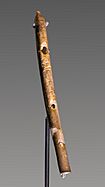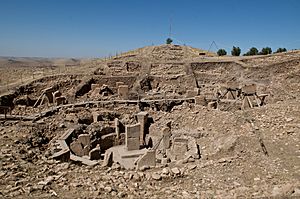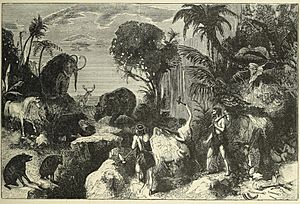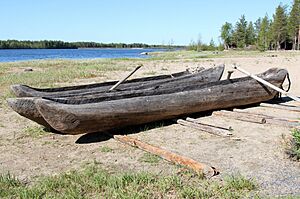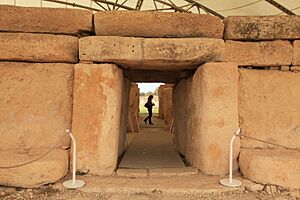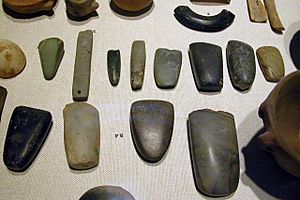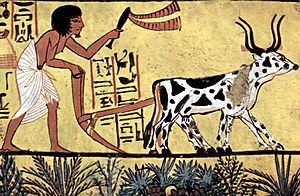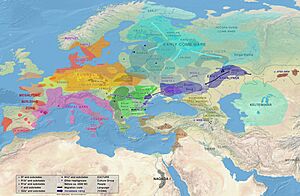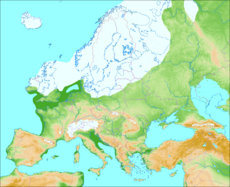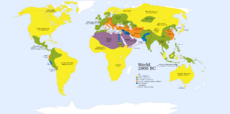Prehistory facts for kids
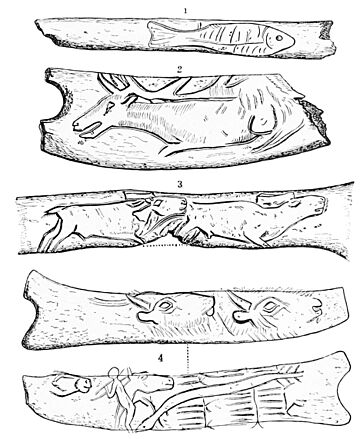
Prehistory is the amazing story of human history before people started writing things down. It began about 3.3 million years ago when our early ancestors first used stone tools. This long period ended when different groups of people invented writing systems. The first known writing appeared around 5,200 years ago.
It took a very long time for writing to spread across the world. Because of this, prehistory ended at different times in different places. For example, in ancient Sumer (Mesopotamia), the Indus Valley Civilisation, and ancient Egypt, writing began early in the Bronze Age. This means their prehistory ended sooner than in other places. Many other civilizations finished their prehistory during the Iron Age.
Historians often divide prehistory into three main parts: the Stone Age, the Bronze Age, and the Iron Age. This system works well for much of Europe, Asia, and North Africa. However, it's not always used in places like Oceania or parts of the Americas. In these areas, metalworking arrived much later, often through contact with other cultures.
Sometimes, a culture is called "protohistory" if others wrote about them, but they didn't have their own writing system yet. Since there are no written records from prehistory, we learn about it from clues left behind. These clues include archaeological finds like tools and buildings, and anthropological evidence like human remains. Scientists use special methods, like radiocarbon dating, to figure out how old these clues are. They also study ancient languages and even use genetic analysis to learn about prehistoric people.
Contents
- Exploring Prehistory: Our Ancient Past
- The Stone Age: Tools and Early Life
- The Copper Age: First Metals
- The Bronze Age: New Materials and Writing
- The Iron Age: Stronger Tools and Empires
- A Journey Through Time: Prehistory Timeline
- Prehistory Around the World
- Discover More About Ancient Times
- See also
Exploring Prehistory: Our Ancient Past
What is Prehistory?
Prehistory is the time before written records. It covers the period from when human-like beings first appeared on Earth until writing was invented. This means we learn about prehistory through objects and remains, not books or documents.
When Did Prehistory Begin and End?
The start of prehistory is usually when the first human-like beings appeared. This date changes depending on the region. For example, the earliest signs of humans in Europe are about 1.3 million years ago. But in Africa and Asia, human ancestors lived much earlier, around 2.5 to 1.8 million years ago.
The end of prehistory also varies greatly. In Egypt, prehistory ended around 3100 BCE when writing began. However, in New Guinea, it ended much later, in the 1870s. This was when an anthropologist named Nicholai Miklukho-Maklai wrote about the native peoples there.
How Do We Divide Prehistory?
To make sense of human prehistory, historians use the "three-age system." This system divides prehistory into three main periods based on the tools people used:
- Stone Age: When most tools were made of stone.
- Bronze Age: When people learned to make tools from bronze.
- Iron Age: When iron tools became common.
Sometimes, there's also a "Chalcolithic" or Copper Age. This is a short period between the Stone Age and the Bronze Age when people first started using copper.
Learning About Our Ancestors
The main way we learn about prehistory is through archaeology. Archaeologists dig up and study old objects and sites. Physical anthropologists study human remains to understand our ancestors.
Scientists also use other fields to learn about prehistory. Geneticists study DNA from ancient bones. Historical linguists look at how languages changed over time. All these different sciences help us piece together the story of our ancient past.
The Stone Age: Tools and Early Life
The Stone Age is the longest part of human prehistory. It's named for the stone tools that people used.
The Old Stone Age (Paleolithic Era)
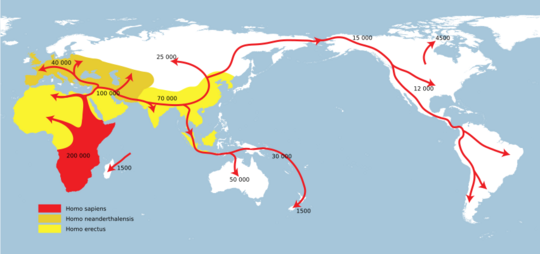
The Palaeolithic, or "Old Stone Age," began about 3.3 million years ago. This was when the very first stone tools were used. It lasted until about 11,650 years ago.
In the early Palaeolithic, tools were simple. Early human ancestors, like Kenyanthropus, likely used them. Later, Homo erectus learned to control fire. Fire helped them cook food, stay warm, see in the dark, and keep wild animals away.
Around 300,000 years ago, early Homo sapiens (modern humans) appeared. This marked the start of the Middle Palaeolithic. During this time, humans definitely used fire. They also started to bury their dead and create early forms of prehistoric art and music.
The Upper Palaeolithic, from 50,000 to 12,000 years ago, saw more organized settlements. Art, like cave paintings, became more common. Throughout the Palaeolithic, people lived as nomadic hunter-gatherers. They moved around to find food and lived in small, equal groups.
The Middle Stone Age (Mesolithic Era)
The Mesolithic, or "Middle Stone Age," began when the last ice age ended, about 10,000 years ago. Glaciers melted, and the climate became warmer. This period ended when people started farming.
In some places, like the Near East, farming began early. So, the Mesolithic was short there. But in areas that had a lot of ice, like Northern Europe, the Mesolithic lasted for thousands of years. People in these areas found plenty of food in the new marshlands.
During the Mesolithic, people used smaller, sharper stone tools called microliths. They also invented fishing tools, stone axes, and wooden objects like canoes and bows. These new tools helped them adapt to their changing environment.
The New Stone Age (Neolithic Era)
The Neolithic, or "New Stone Age," started around 10,200 BCE in some parts of the Middle East. It was a time of huge changes, often called the "Neolithic Revolution." This era ended when metal tools became common.
During the Neolithic, humans learned to farm. They started growing crops like wheat and millet. They also began to domesticate animals like dogs, sheep, and goats. This meant people no longer had to move constantly to find food.
People started building permanent villages and settlements. Houses were often made of mudbrick. Some villages even had stone walls to protect their animals and people. The invention of pottery also happened during this time. Burial findings suggest people had special ways of honoring the dead.
The Copper Age: First Metals
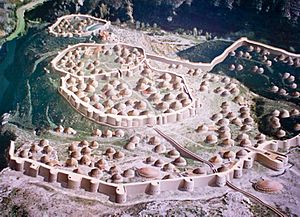
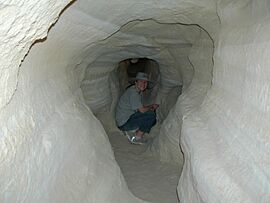
The "Chalcolithic," "Eneolithic," or "Copper Age" was a transition period. It came after the Stone Age and before the Bronze Age. During this time, people still used many stone tools, but they also started making some tools and weapons from copper.
Scientists have found evidence of copper making from 7,500 years ago in Serbia. This shows that people learned to work with copper very early. The Copper Age was an important step towards the widespread use of metals.
The Bronze Age: New Materials and Writing
The Bronze Age began when people learned to make bronze. Bronze is a stronger metal made by mixing copper and tin. This period is when some civilizations, like those in Mesopotamia and Egypt, started using written records. For these cultures, the Bronze Age marks the end of their prehistory.
Making bronze was a big step in metalworking. Tin was rare, so people had to trade for it. This led to the creation of long-distance trade routes. Bronze was often used for weapons and special items, and it was sometimes kept by important leaders.
By the end of the Bronze Age, large states and early empires had grown in places like Egypt, China, and Mesopotamia. These powerful groups often had writing systems and strong armies.
The Iron Age: Stronger Tools and Empires
The Iron Age began when people learned to work with iron. Iron is much more common than tin, but it's harder to work with. It requires higher heat to melt and shape. Once people figured out how to do this, iron tools and weapons became widespread.
Iron tools were stronger and more available than bronze ones. This meant armies could be equipped more easily. The Iron Age also saw other changes, like more advanced farming methods and new artistic styles.
For many civilizations, the Iron Age was when their prehistory ended. Often, this happened as powerful empires, like the Roman Empire, expanded and brought writing to new areas. Even before being conquered, some cultures had a "protohistory" because other literate cultures wrote about them.
A Journey Through Time: Prehistory Timeline
These dates are estimates and can change with new discoveries. BP means "Before Present" (before 1950). BCE means "Before Common Era."
Key Moments in the Paleolithic
- c. 3.3 million BP: The earliest stone tools were used.
- c. 2.8 million BP: The genus Homo (our direct ancestors) appeared.
- c. 600,000 BP: People started hunting and gathering food.
- c. 400,000 BP: Early humans learned to control fire.
- c. 300,000 BP: Homo sapiens sapiens (anatomically modern humans) appeared in Africa.
- c. 170,000–83,000 BP: The invention of clothing.
- c. 80,000–50,000 BP: Homo sapiens began to leave Africa and spread across the world.
- c. 45,000 BP: Early cultures like the Châtelperronian began in France.
- c. 40,000 BP: Humans settled in the southern half of Australia.
- c. 32,000 BP: Famous cave paintings, like those in Chauvet Cave in France, were created.
- c. 25,000 BP: The oldest known permanent human settlement was founded in what is now the Czech Republic.
- c. 14,800 BP: A wet and fertile period began in North Africa, making the Sahara green.
Important Steps in the Mesolithic and Neolithic
- c. 12,500 to 9,500 BCE: The Natufian culture in the Middle East, a group of hunter-gatherers who lived in one place and may have grown rye.
- c. 9,400–9,200 BCE: Figs were cultivated in the village of Gilgal I in the Jordan Valley. This might be the first known example of farming.
- c. 9,000 BCE: Large stone pillars were set up at Göbekli Tepe in Turkey.
- c. 8,000–7,000 BCE: Farming of barley and wheat began in northern Mesopotamia.
- c. 4,700–4,500 BCE: Large circular enclosures were built in Central Europe.
The Dawn of Metals: Chalcolithic and Beyond
- c. 3,700 BCE: Early forms of writing, called proto-cuneiform, appeared in Sumer.
- c. 3,300 BCE: Approximate death date of "Ötzi the Iceman," found with a copper axe.
- c. 3,100 BCE: Skara Brae, a stone village with houses and a sewer system, was built in Scotland.
- c. 3,000 BCE: Construction of Stonehenge began.
- c. 3,000 BCE: The Yamnaya culture spread from Eastern Europe into Europe and Asia, bringing new languages.
Prehistory Around the World
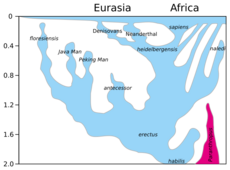
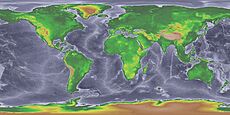
Prehistory happened differently in various parts of the world. Here are some regions where you can learn more:
- Old World
- Prehistoric Africa
- Prehistoric Asia
- Prehistoric China
- Prehistoric Korea
- Japanese Paleolithic
- Indus valley civilization
- Prehistoric Europe
- Paleolithic Europe
- Neolithic Europe
- Bronze Age Europe
- Iron Age Europe
- Prehistoric Britain
- Prehistoric Ireland
- New World
- Pre-Columbian Americas
- Prehistory of Newfoundland and Labrador
- Oceania
- Prehistoric Australia
- Prehistoric New Zealand
Discover More About Ancient Times
- Archaic humans
- Human evolution
- Paleoanthropology
- Prehistoric medicine
- Prehistoric music
- Prehistoric religion
- Prehistoric warfare
- Uncontacted peoples
See also
 In Spanish: Prehistoria para niños
In Spanish: Prehistoria para niños



